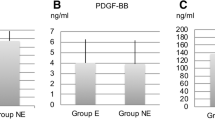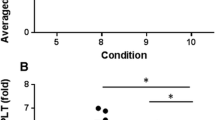Abstract
Purpose
Platelet-rich plasma (PRP) is an autologous prepared plasma enriched with platelets and obtained after a centrifugal separation and aggregation procedure. However, the optimized preparation protocol for PRP is still controversial and there are no standardized preparation protocols. The aim of this study is to show the effect of time and force of the centrifugation on the concentrations of platelets and to optimize the effective PRP preparation protocol.
Methods
For the study, whole blood was drawn into 24 different 6-ml standard tubes containing 0.6 ml anticoagulant citrate dextrose solution—formula A. The samples were centrifuged separately at forces of 45×g, 180×g, 400×g, 725×g, 1130×g and 1630×g for 5, 10, 15 and 20 min. Every sample was analyzed, and a comparison was made between all groups.
Results
No significant difference was observed in terms of platelet concentration, mean platelet volume or platelet mass between all groups (p > 0.05). The mean ± SD of platelet mass in baseline is 1890 ± 134 × 103 fL/μL. The mean ± SD of platelet mass in the high centrifugal force of 1630×g was 3395 ± 564 × 103 fL/μL, 2638 ± 425 × 103 fL/μL, 2355 ± 449 × 103 fL/μL and 2109 ± 41 × 103 fL/μL over times of 5, 10, 15 and 20 min, respectively. The mean ± SD of platelet mass in the low centrifugal force of 45×g was 2002 ± 1623 × 103 fL/μL, 2491 ± 1591 × 103 fL/μL, 2611 ± 876 × 103 fL/μL and 3003 ± 511 × 103/μL over times of 5, 10, 15 and 20 min, respectively.
Conclusions
Platelets should be evaluated with platelet mass not including platelet concentrations alone, but also with mean platelet volume, which symbolizes the size of platelets while comparing platelet-rich plasma preparation protocols and kits. This could be a new starting point for comparison of PRP for all applications in the literature. All centrifugation forces and times could produce biologically reactive PRP. It may be only suggested that if high acceleration force is used, low durations should be selected, or if low acceleration force is used, long time of centrifugation should be selected.
No Level Assigned
This journal requires that authors assign a level of evidence to each article. For a full description of these Evidence-Based Medicine ratings, please refer to the Table of Contents or the online Instructions to Authors www.springer.com/00266.



Similar content being viewed by others
References
Ozer K, Kankaya Y, Çolak Ö (2018) An important and overlooked parameter in platelet rich plasma preparation: the mean platelet volume. J Cosmet Dermatol. https://doi.org/10.1111/jocd.12682
Perez AGM, Lana JFSD, Rodrigues AA et al (2014) Relevant aspects of centrifugation step in the preparation of platelet-rich plasma. ISRN Hematol 2014:176060. https://doi.org/10.1155/2014/176060
Italiano JE, Hartwig JH (2013) Megakaryocyte development and platelet formation. In: Michelson AD (ed) Platelets, 3rd edn. Elsevier, London, pp 27–49
Sagit M, Korkmaz F, Kavugudurmaz M, Somdas MA (2012) Impact of septoplasty on mean platelet volume levels in patients with marked nasal septal deviation. J Craniofac Surg 23:974–976. https://doi.org/10.1097/SCS.0b013e31824e2c08
Park Y, Schoene N, Harris W (2002) Mean platelet volume as an indicator of platelet activation: methodological issues. Platelets 13:301–306. https://doi.org/10.1080/095371002220148332
Araki J, Jona M, Eto H et al (2012) Optimized preparation method of platelet-concentrated plasma and noncoagulating platelet-derived factor concentrates: maximization of platelet concentration and removal of fibrinogen. Tissue Eng Part C Methods 18:176–185. https://doi.org/10.1089/ten.TEC.2011.0308
Akhundov K, Pietramaggiori G, Waselle L et al (2012) Development of a cost-effective method for platelet-rich plasma (PRP) preparation for topical wound healing. Ann Burns Fire Disasters 25:207–213
Transparency Market Research (2015) Platelet rich plasma market—global industry analysis, size, share, growth, trends & Forecast 2014–2020. https://globenewswire.com/news-release/2015/03/23/717697/10125904/en/Platelet-Rich-Plasma-PRP-Market-Expected-to-Reach-USD-0-35-Billion-Globally-in-2020-growing-at-a-CAGR-of-11-9-from-2014-to-2020-Transparency-Market-Research.html. Accessed 12 Apr 2019
Castillo TN, Pouliot MA, Kim HJ, Dragoo JL (2011) Comparison of growth factor and platelet concentration from commercial platelet-rich plasma separation systems. Am J Sports Med 39:266–271. https://doi.org/10.1177/0363546510387517
Graziani F, Ivanovski S, Cei S et al (2006) The in vitro effect of different PRP concentrations on osteoblasts and fibroblasts. Clin Oral Implants Res 17:212–219. https://doi.org/10.1111/j.1600-0501.2005.01203.x
Rappl LM (2011) Effect of platelet rich plasma gel in a physiologically relevant platelet concentration on wounds in persons with spinal cord injury. Int Wound J 8:187–195. https://doi.org/10.1111/j.1742-481X.2011.00770.x
Weibrich G, Hansen T, Kleis W et al (2004) Effect of platelet concentration in platelet-rich plasma on peri-implant bone regeneration. Bone 34:665–671. https://doi.org/10.1016/j.bone.2003.12.010
Anitua E, Sánchez M, Zalduendo MM et al (2009) Fibroblastic response to treatment with different preparations rich in growth factors. Cell Prolif 42:162–170. https://doi.org/10.1111/j.1365-2184.2009.00583.x
Leitner GC, Gruber R, Neumüller J et al (2006) Platelet content and growth factor release in platelet-rich plasma: a comparison of four different systems. Vox Sang 91:135–139. https://doi.org/10.1111/j.1423-0410.2006.00815.x
Levin J (2013) The evolution of mammalian platelets. In: Michelson AD (ed) Platelets, 3rd edn. Elsevier, London, pp 3–25
Kuter DJ (1996) The physiology of platelet production. Stem Cells 14(Suppl 1):88–101. https://doi.org/10.1002/stem.5530140711
Whitfield JB, Martin NG (1985) Genetic and environmental influences on the size and number of cells in the blood. Genet Epidemiol 2:133–144. https://doi.org/10.1002/gepi.1370020204
Thompson CB (1986) From precursor to product; how do megakaryocytes produce platelets. In: Levine RF, Williams N, Levin J (eds) Megakaryocyte development and function. New York, p 361
Martin JF, Kristensen SD, Mathur A et al (2012) The causal role of megakaryocyte–platelet hyperactivity in acute coronary syndromes. Nat Rev Cardiol 9:658–670. https://doi.org/10.1038/nrcardio.2012.131
Lee JW, Kwon OH, Kim TK et al (2013) Platelet-rich plasma: quantitative assessment of growth factor levels and comparative analysis of activated and inactivated groups. Arch Plast Surg 40:530–535. https://doi.org/10.5999/aps.2013.40.5.530
Acknowledgements
We would like to thank Assoc. Prof. Mustafa Gurhan Ulusoy and Assoc. Prof. Gurcan Aslan for their polite guidance and advice. We also want to thank Assoc. Prof. Bulent Alioglu for allowing us to use the hematology laboratory.
Author information
Authors and Affiliations
Corresponding author
Ethics declarations
Conflict of interest
All the authors (KO, YK, OC, UK) confirmed no funding supporting the work and no statement of financial interest and no conflict of interest. All authors bear the responsibility of this letter.
Ethical Approval
All experimental protocols used in this study were conducted according to the ethical guidelines of the Declaration of Helsinki and international regulations. Approval by the ethics committee of our institute (No: 0565/4677) was obtained.
Informed Consent
Informed consents of volunteer subjects were taken.
Additional information
Publisher's Note
Springer Nature remains neutral with regard to jurisdictional claims in published maps and institutional affiliations.
Rights and permissions
About this article
Cite this article
Ozer, K., Kankaya, Y., Colak, O. et al. The Impact of Duration and Force of Centrifugation on Platelet Content and Mass in the Preparation of Platelet-Rich Plasma. Aesth Plast Surg 43, 1078–1084 (2019). https://doi.org/10.1007/s00266-019-01375-9
Received:
Accepted:
Published:
Issue Date:
DOI: https://doi.org/10.1007/s00266-019-01375-9




